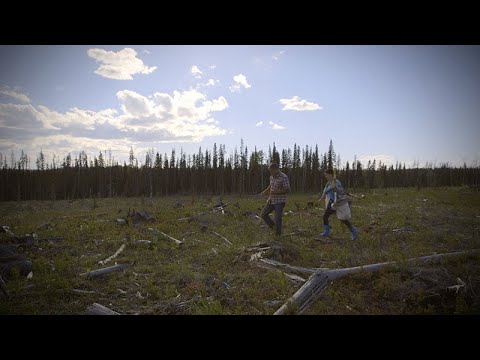Career Overview
Silviculture and forestry workers perform a variety of duties related to reforestation and to the management, improvement and conservation of forests. This occupational group includes forest firefighters.
People in this occupation:
- May find job opportunities through logging companies, contractors and government services, depending on the specific occupation
- May be salaried employees, while others, such as tree planters, are typically paid by the amount of work completed
- Need to be physically fit, well coordinated and comfortable with rugged terrain
- Should also be self-motivated, adaptable and comfortable working in remote areas under a range of conditions
- Need the ability to apply reasoning and make decisions
- May be required to work independently with minimal supervision
- Should be able to do map and photo reading, compassing and distancing, identification of forest plants and trees, measuring and recording, and operation of GPS units
Duties
Silviculture and forestry workers perform some or all of the following duties:
- Assess sites, select seedlings and plant trees using manual planting tools in reforestation areas
- Operate power thinning saw to thin and space trees in reforestation areas
- Operate chain saw to thin young forest stands
- Control weeds and undergrowth in regenerating forest stands using manual tools and chemicals
- Complete firefighting reports and maintain firefighting equipment
- Dig trenches, cut trees, pump water on burning areas to fight forest fires under direction of fire suppression officer or forestry technician
- Operate and maintain a skidder, bulldozer or other prime mover to pull a variety of scarification or site preparation equipment over areas to be regenerated
- Do other silviculture duties, such as collecting seed cones, pruning trees, helping with planting surveys and marking trees for later operations
Earnings
Earnings is income that workers receive in exchange for their labour. Depending on the type of employment, earnings can be in the form of wages (hourly), salaries (fixed monthly or annual) or self-employed earnings.
Work Environment
# Workers Employed
1,395% Employed Full Time
24%Earnings is income that workers receive in exchange for their labour. Depending on the type of employment, earnings can be in the form of wages (hourly), salaries (fixed monthly or annual) or self-employed earnings.
Career Pathways
Experienced silviculture and forestry workers may advance to supervisory and project management positions. University-trained professionals could become senior managers or CEOs.
With additional education, these workers may move into related occupations such as forestry technician, technologist or registered professional forester.
Related Careers
Occupational Interests
It’s important to understand what kinds of occupations align with your interests.
For more about occupational interests visit Skills for the Future Workforce > Characteristics.
Here are the top occupational interest(s) for this career profile:
Job Titles
Education, Training and Skills
Employment requirements for silviculture and forestry workers may vary from one employer to another. As well, in this diverse occupational group, the amount of education and skill required varies significantly depending on the job and its responsibilities.
Training and requirements may include:
- Completion of secondary school
- Completion of a college or other specialized program for silviculture workers or forestry crew workers
- First aid training, such as Occupational First Aid (OFA) Level 3 and Workplace Hazardous Materials Information System (WHMIS) training
- A class 4 British Columbia driver's licence
- An OFA Level 1 and transportation endorsement, with OFA Level 3 is recommended for firefighters
Most training is provided by employers or contractors to their employees. The BC Forest Safety Council also offers a range of courses for small employers and forest workers of all types. For more information please see the BC Forest Safety Council website at www.bcforestsafe.org.
The BC Safe Silviculture Project, a partnership between the BC Forest Safety Council and the Western Silvicultural Contractors' Association, has identified six silviculture functions that require training leading to competency certification. These include resource road driving, ATV operation, power saw operation, prescribed burning, wildfire fighting and silviculture supervision. Training is delivered by a variety of methods (i.e., through employers, in formal classroom setting, etc.).
Environmental management system knowledge is also beneficial.
Education programs in B.C.
The following program areas are related to this occupation:
- Fire Fighting Related

Skills
Every job calls for a certain set of skills. Knowing those skills is the first step in finding a good career fit.
Here, you will find the 10 most relevant workplace skills. Some are more important to achieving success in a certain career than others. These skills may come naturally to you or you may need to gain them through education, training and experience.
See the list of work-related skills below, ranked in order of importance for this career. Check out the list and see if this career matches your skills—take that first step!
Adjusting actions in relation to others' actions.
Talking to others to share information effectively.
Using logic and reasoning to identify the strengths and weaknesses of alternative solutions, conclusions or approaches to problems.
Keeping track of and assessing your performance, other individuals, or organizations to make improvements or take corrective action.
Giving full attention to what other people are saying, taking time to understand the points being made, asking questions as appropriate, and not interrupting at inappropriate times.
Considering the relative costs and benefits of potential actions to choose the most appropriate one.
Being able to solve novel, ill-defined problems in complex, real-world settings.
Understanding how new information could be used to solve current and future problems in making decisions.
Managing one’s own time and the time of others.
Understanding written sentences and paragraphs in work-related documents.
Labour Market Statistics
Discover data, facts and information that have been gathered and analyzed. Learn about the characteristics of the economy and labour market in B.C.
Employment
Find out about employment types and trends by region and industry.
Employment
1,395Employment by Region















| Region | Employment | % Employment of this Occupation |
|---|---|---|
| Cariboo | 285 | 20.4% |
| Kootenay | 135 | 9.7% |
| Mainland/Southwest | 225 | 16.1% |
| North Coast and Nechako | 175 | 12.5% |
| Northeast | 40 | 2.9% |
| Thompson-Okanagan | 270 | 19.4% |
| Vancouver Island/Coast | 255 | 18.3% |
Labour Market Outlook
The B.C. Labour Market Outlook is a 10-year forecast of the expected supply and demand for labour in the province. It’s usually updated every year. The purpose is to provide British Columbians with the knowledge to make informed decisions on careers, skills training, education and hiring.
Forecasted Job Openings (2023-2033)
210Forecasted Job Openings
Forecasted Employment Growth Rate
Composition of Job Openings
Job Openings by Region (2023-2033)















| Region | Job Openings | Avg. Annual Employment Growth |
|---|---|---|
| Cariboo | 60 | -0.7% |
| Kootenay | 10 | -0.5% |
| Mainland/Southwest | 30 | 0.0% |
| North Coast and Nechako | 30 | -0.4% |
| Northeast | 10 | -0.8% |
| Thompson-Okanagan | 30 | -0.3% |
| Vancouver Island/Coast | 40 | -0.2% |
Industry Highlights
Learn about the opportunities in B.C.'s major industries, including employment trends, earning potential, locations of work and more.
Forecasted Job Openings by Industry
| Industry | Job Openings (2023-2033) |
|---|---|
| Public Administration | 110 |
| Business, Building And Other Support Services | 40 |
| Forestry, Logging And Support Activities | 40 |
| Professional, Scientific And Technical Services | 10 |
| Health Care And Social Assistance | 10 |
Insights from Industry
Employment opportunities are expected to arise from both new job creation and the need to replace experienced workers who retire. However, due to the small size of this occupational group, the number of openings will be somewhat limited.
In recent years, a number of factors, such as environmental concerns, land use legislation, the rising Canadian dollar, a declining U.S. housing market, trade disputes and mill closures, have reduced the demand for logging activity in B.C.. As a result, the need for reforestation and enhanced silviculture activity (such as pruning, spacing and thinning young trees) has declined. This has reduced the need for silviculture and forestry workers.
On the other hand, other factors may have a somewhat positive impact on this occupational group. For example, a provincial government plan to shift from old-growth to second-growth harvesting in coastal forests involves cultivating faster-growing trees, increased fertilization and a shorter growth-to-harvest cycle. This activity, as well as a planned increase in the planting and harvesting of deciduous hardwoods, would increase opportunities for silviculture workers if put into place.
In addition, climate change is contributing to significant changes in provincial forests. In recent years, the mountain pine beetle and forest fires have destroyed millions of hectares of woodland. The silviculture industry is likely to play a role in the restoration of these areas.
Silviculture and forestry workers are now required to capture more information about a broader array of resources, including fish, wildlife, soils, and cultural and heritage features. There has also been a gradual increase in the amount of technology and mechanization used in these jobs. As a result of these developments, more in-depth training of these workers is required. Industry sources also predict more opportunities for workers highly skilled in prescribed burn and fuel management for ecosystem restoration.
Demand for forest firefighters varies, but is generally steady during long, dry summers. However, the majority of firefighters hired by the British Columbia Forest Service are workers with previous experience who are recalled to work rather than new hires. To learn about other firefighting occupations, see the profile for Firefighters (NOC 4312).
Resources
-
Forest Professionals BC – Job Centrewww.fpbc.ca/job/
-
Forest Professionals BCwww.fpbc.ca/
-
B.C. Ministry of Forests, Lands, Natural Resource Operations and Rural Developmentwww.gov.bc.ca/forests
-
Council of Forest Industries (COFI)www.cofi.org
-
British Columbia Forest Safety Council (BCFSC)www.bcforestsafe.org
-
British Columbia Community Forest Association (BCCFA)bccfa.ca
-
Canadian Forests Websitewww.canadian-forests.com
-
Forest Practices Boardwww.bcfpb.ca
-
Government of B.C. – Silviculturewww2.gov.bc.ca/gov/content/industry/forestry/managing-our-forest-resources/silviculture
-
Natural Resources Canadawww.nrcan.gc.ca/forests
-
Selkirk College – Pre-Season Training Programselkirk.ca/treeplanting/pre-season-training-program
-
Tree-planter.com – An Online Resource for Tree Planterswww.tree-planter.com
-
Victoria Innovation, Advanced Technology and Entrepreneurship Council (VIATEC)www.viatec.ca
-
Western Forestry Contractors' Associationwfca.ca
-
Wildfire Statuswww2.gov.bc.ca/gov/content/safety/wildfire-status









